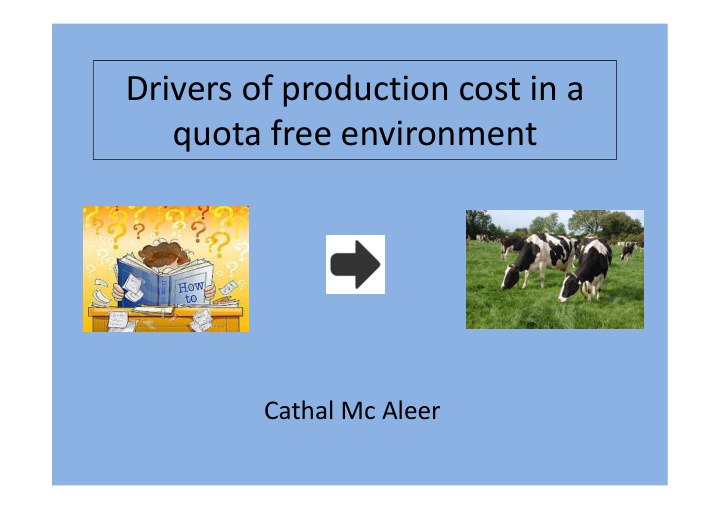



Drivers of production cost in a quota free environment Cathal Mc Aleer
Abolition of quota • The abolition of milk quota in April 2015 will enable an increase in sales.. OF: Concentrates • Feeder wagons • Buffer feeding ingredients • Antibiotics • Mineral ‘cocktails’ etc •
• Northern Ireland: - Quota has not been binding in NI since 1995
Northern Ireland • Output per cow has increased to 6500 litres 3.24% Protein 4.01% Butterfat SCC: 228 (‘000/ml) (Source: DARDNI, CSO) • Herd size has increased from 62 – 90 cows • ‘Output per cow’ has become key focus – Assumed but not proven this drives margin
Effects of increasing output/cow • Reduced milk from forage= concentrate driven milk • Decline in grassland management – Pre grazing covers in excess of 2500kgsDM/ha – Residuals 350-600kgsDM/ha • Infertility increasing – wide calving spread – Acceptance of extended lactations – dependency on outside assistance - ‘RMS’ etc • Sales people gaining hugely
Herd Nutrition: myths and realities Myths Reality 18% dietary crude protein 16% Balance Protein & Energy required Add to cost Drive Profit
Herd Nutrition: myths and realities Myths Reality 18% dietary crude protein 16% Balance Protein & Energy required Too cold in spring for turnout Grass allocation/rumen fill is key Add to cost Drive Profit
Herd Nutrition: myths and realities Myths Reality 18% dietary crude protein 16% Balance Protein & Energy required Too cold in spring for turnout Grass allocation/rumen fill is key Performance drops at turnout Performance highlights grass quality issues Add to cost Drive Profit
Herd Nutrition: myths and realities Myths Reality 18% dietary crude protein 16% Balance Protein & Energy required Too cold in spring for turnout Grass allocation/rumen fill is key Performance drops at turnout Performance highlights grass quality issues Farms too heavy for early grazing Spring – 90 days Infrastructure essential Add to cost Drive Profit
Herd Nutrition: myths and realities Myths Reality 18% dietary crude protein 16% Balance Protein & Energy required Too cold in spring for turnout Grass allocation/rumen fill is key Performance drops at turnout Performance highlights grass quality issues Farms too heavy for early grazing Spring – 90 days Infrastructure essential Breeding sufficient for solids Breeding dictates 60% of solids payment, tweak diet output – must breed for fat and protein Add to cost Drive Profit
Calving Pattern • Average calving interval approx. 410-420 days – Predominantly year round calving – Data on fertility performance is seriously lacking • Result: - Overfeeding late lactation cows - Increased labour demands - Less ‘Peaks’ per lifetime - Youngstock grouping issues - Creates feeding difficulties during winter
Calving Pattern • Factors effecting infertility - Effect of lameness and SCC on fertility - Prolonged housing period – heat expression - Poor nutritional management - Reluctance to cull empty cows - Genetics • How is infertility being addressed - It is not being addressed! - Heat detection software - Crossbreeding???
Business Targets • Retain maximum amount of milk cheque • Simplified, profitable system that is repeatable • Good quality of life • Industry leader – attract young people to industry
So how do we get there…?
Nutrition • Control inputs and costs • Educate yourself on nutrition – Maximise energy intake – Balance dietary protein – Balance dietary fibre – Adequate vit/mins • Its not that complicated!
Improving grass utilisation • Planning: – Grass budgeting spring summer autumn – Soil fertility – Silage quality • Implementation: – Weekly grass measurement – Grass allocation – Minimise poaching – Supplementation
Lessons learned within a quota environment • Quota has curtailed expansion – do not lose experience gained during this time – Efficiency before scale – Keeping feed costs down – Controlling capital spend – Culling low performance cows
In conclusion • Grass measurement important to ALL dairy farmers • Must educate ourselves on feed & nutrition • Have to control calving pattern • Excellent advisory body – NI prime example of a non research-driven industry • Profitability must be the driving factor
Thank you for your attention!
Recommend
More recommend